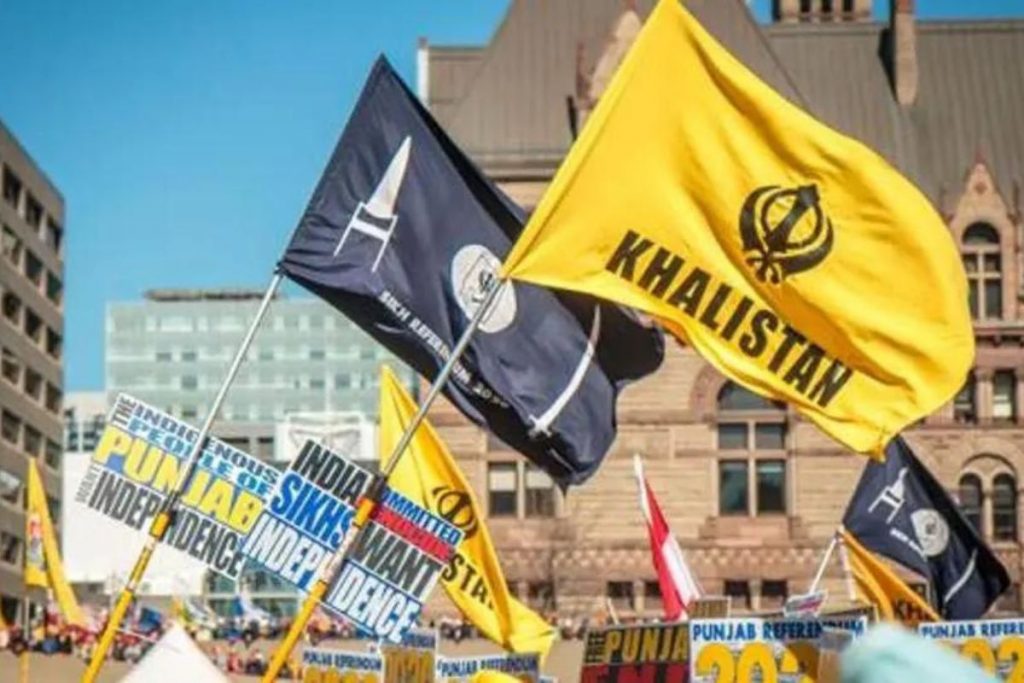New Delhi: We have often heard the term ‘Khalistan’ in India as it became a thing in the past with the country winning over the horrifying period of highest insurgency in Punjab, the assassination of a powerful prime minister, followed by anti-Sikh riots.
However, some incidents in the last few months have reminded us of the dark past and it seems that the ‘Khalistan’ movement is coming onto the surface all over again. To understand the current incidents, it is important to delve into the evolution, dissolution, and reappearance of the movement. Let’s take a look:
Historical roots
The Khalistan movement started as the Sikh separatist movement to create a separate sovereign state called Khalistan (Land of the Khalsa) which would be the homeland of the Sikhs. They wanted to develop their state in Punjab which includes both India and Pakistan.
Khalsa is referred to as the community that practices Sikhism as a faith and a special group of initiated Sikhs. The Khalsa tradition was introduced in 1699 by Guru Gobind Singh, the 10th Guru, after his father Guru Tegh Bahadur, was beheaded in the reign of Aurangzeb.
The Khalse community gave a new path to Sikhism with a new system of leadership and gave a political as well as a religious vision to the Sikh community. A Khalsa was then established to protect people from Islamic religious persecution.
In the modern age, the idea to form a separate Sikh homeland began during the fall of the British empire. In 1940 for the first time, an explicit call for Khalistan was made in a pamphlet by the same name.
With the political and financial support of the Sikh diaspora, the Khalistan movement started gathering momentum in Punjab. It continued through the 1970s and reached its peak in the late 1980s as a separatist movement.
The movement started spreading to Chandigarh, much of northern India, and parts of western India.
Jagjit Singh Chohan is the discredited founder of the Khalistan movement. In his early life, he was a dentist and was later first elected to the Punjab Assembly in 1967. He then became the finance minister. However, in 1969 he lost the Assembly elections.
Building an overseas base
Chohan moved to Britain in 1969 and began campaigning for Khalistan to be created. In 1971, he went to Nankana Sahib in Pakistan and initiated setting up a Sikh government.
Chohan was considered a Sikh leader by Yahaya Khan, the military dictator of Pakistan, and was handed over certain Sikh relics which he took with him to Britain. These relics helped him to gather support and followers. Thus, he visited the US at the invitation of his supporters in the Sikh diaspora.
On October 13, 1971, The New York Times carried a paid ad asking for an independent Sikh state which helped Chohan to gather huge funds from the overseas community.
He maintain a good relationship with the then Prime Minister of Pakistan, Zulfikar Ali Bhutto, who assured him of all assistance in creating Khalistan after the 1971 Indo-Pak war. In 1979, he formed the Khalistan National Council 1979.
On April 12, 1980, Chohan officially announced the formation of the National Council of Khalistan at Anandpur Sahib and declared himself to be the president. Balbir Singh Sindhu as its Secretary-General.
Eventually, Chohan presented himself as the president of the Republic of Khalistan, set up a cabinet, and issued Khalistani passports, stamps, and currency.
On June 13, 1984, Chohan announced a government in exile, and on October 31, 1984, Prime Minister Indira Gandhi was assassinated.
In 1989, Chohan hoisted the flag of Khalistan at the Anandpur Sahib gurdwara in Punjab. Later, his Indian passport was left invalid and the Indians protested when he was allowed to enter the US with an invalid passport.
Mellowing down the radicals
Chohan soften his stance gradually and accepted to lessen India’s tension by accepting surrenders by militants. However, their other organisations in Britain and North America remain devoted to the cause of Khalistan.
In June 2001, Chohan was permitted to return to India after he was granted a pardon by the Atal Bihari Vajpayee government.
In 2002, he founded a party named Khalsa Raj Party which aimed at continuing the campaign for Khalistan. However, the notion appeared not to be interesting to the new generations of Sikhs.
In 2007, Chohan passed away with the Khalistan movement being petered out.
The end of insurgency
In the 1990s, the movement faded away and gradually it failed due to several factors namely primarily heavy police crackdown on separatists, factional infighting, and disenchantment from the Sikh population.
However, recently questions have been raised regarding the resurrection of the notion of Khalistan.
In early 2018, police arrested some militant groups in Punjab. The then Punjab’s CM Amarinder Singh said that the extremism was backed by Pakistan’s Inter-Service Intelligence and Khalistani sympathiser in Canada, Italy, and the UK.
Khalistan seems to revive in Punjab
In this year’s February, pro-Khalistani groups like Sikhs for Justice (SFJ) have been trying to revive the Khalistani movement and sentiments in Punjab.
Reportedly, an NIA team reached Canada last November and found that over one lakh USD was collected in the name of a farmer’s protest.
On May 5, Haryana Police arrested four people at a toll plaza in Karnal carrying three IEDs weighing 2.5 kg each.
On May 8, flags of Khalistan were found sticking to the main entrance of the Himachal Pradesh Assembly complex in Dharamsala. Himachal Pradesh Police booked SFJ leader Gurpatwant Singh Pannun under UAPA and sealed the state’s borders and beefed up security in the state citing pro-Khalistan activities.
On May 9, a Pakistani-made rocket-propelled grenade explosion happened at the Punjab Police Intelligence headquarters just a day after state police seized an IED loaded with RDX from Punjab’s Tarn Tarn district. This happened following the communal rift between Hindu and Sikh groups in Patiala.

